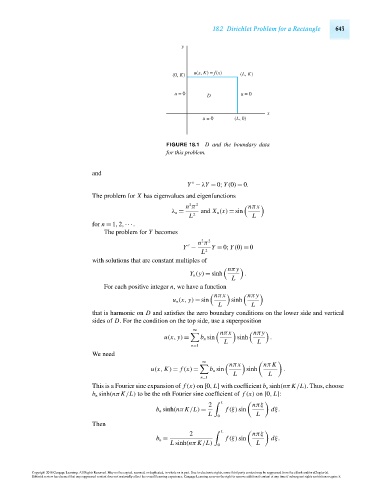Page 663 - Advanced_Engineering_Mathematics o'neil
P. 663
18.2 Dirichlet Problem for a Rectangle 643
y
(0, K) u(x, K) = f(x) (L, K)
u = 0 u = 0
D
x
u = 0 (L, 0)
FIGURE 18.1 D and the boundary data
for this problem.
and
Y − λY = 0;Y(0) = 0.
The problem for X has eigenvalues and eigenfunctions
2
n π 2 nπx
λ n = and X n (x) = sin
L 2 L
for n = 1,2,···.
The problem for Y becomes
2
n π 2
Y − Y = 0;Y(0) = 0
L 2
with solutions that are constant multiples of
nπy
Y n (y) = sinh .
L
For each positive integer n, we have a function
nπx nπy
u n (x, y) = sin sinh
L L
that is harmonic on D and satisfies the zero boundary conditions on the lower side and vertical
sides of D. For the condition on the top side, use a superposition
∞
nπx nπy
u(x, y) = b n sin sinh .
L L
n=1
We need
∞
nπx nπ K
u(x, K) = f (x) = b n sin sinh .
L L
n=1
This is a Fourier sine expansion of f (x) on [0, L] with coefficient b n sinh(nπ K/L). Thus, choose
b n sinh(nπ K/L) to be the nth Fourier sine coefficient of f (x) on [0, L]:
2 L nπξ
b n sinh(nπ K/L) = f (ξ)sin dξ.
L 0 L
Then
2 L nπξ
b n = f (ξ)sin dξ.
L sinh(nπ K/L) 0 L
Copyright 2010 Cengage Learning. All Rights Reserved. May not be copied, scanned, or duplicated, in whole or in part. Due to electronic rights, some third party content may be suppressed from the eBook and/or eChapter(s).
Editorial review has deemed that any suppressed content does not materially affect the overall learning experience. Cengage Learning reserves the right to remove additional content at any time if subsequent rights restrictions require it.
October 14, 2010 15:27 THM/NEIL Page-643 27410_18_ch18_p641-666

